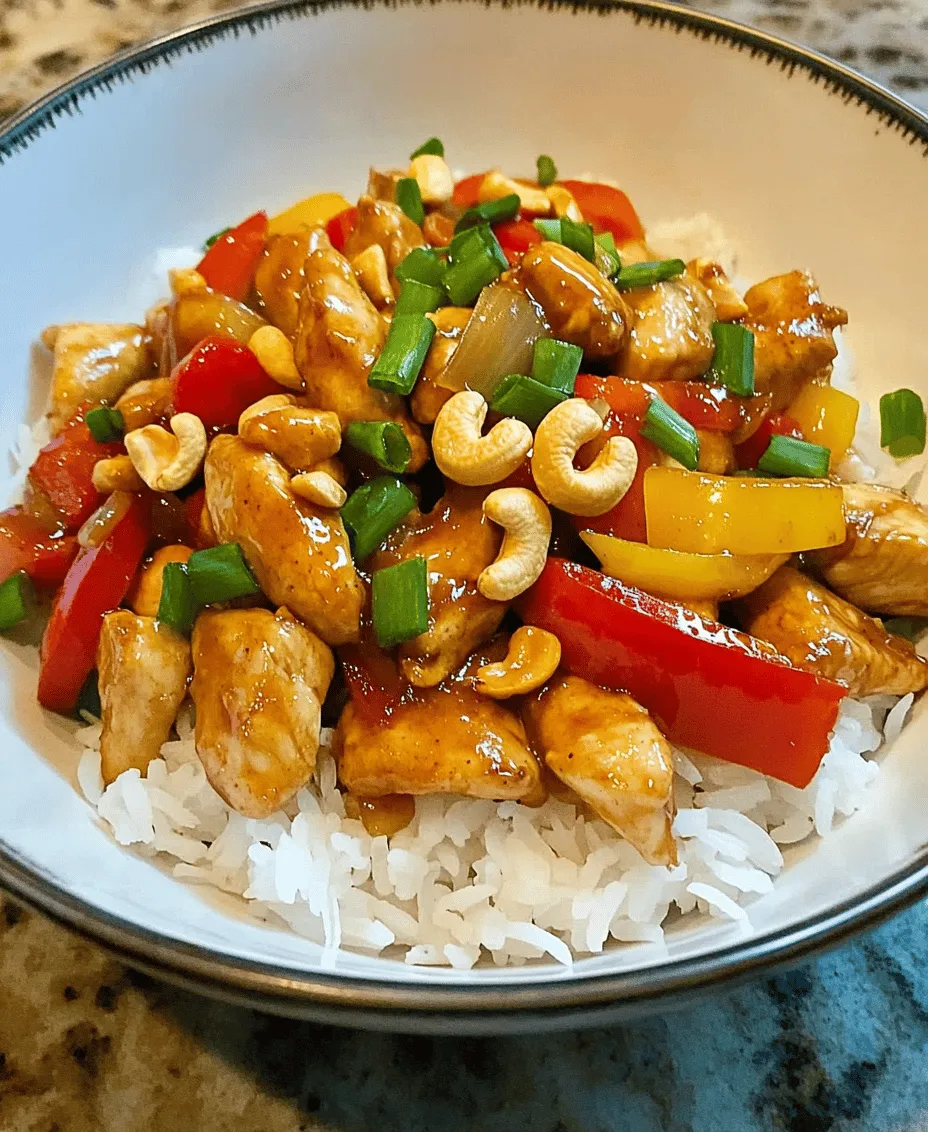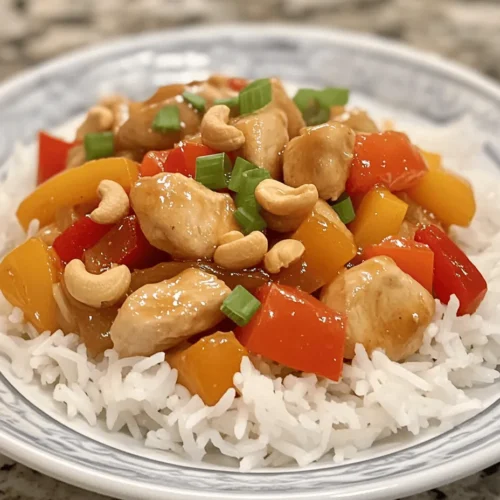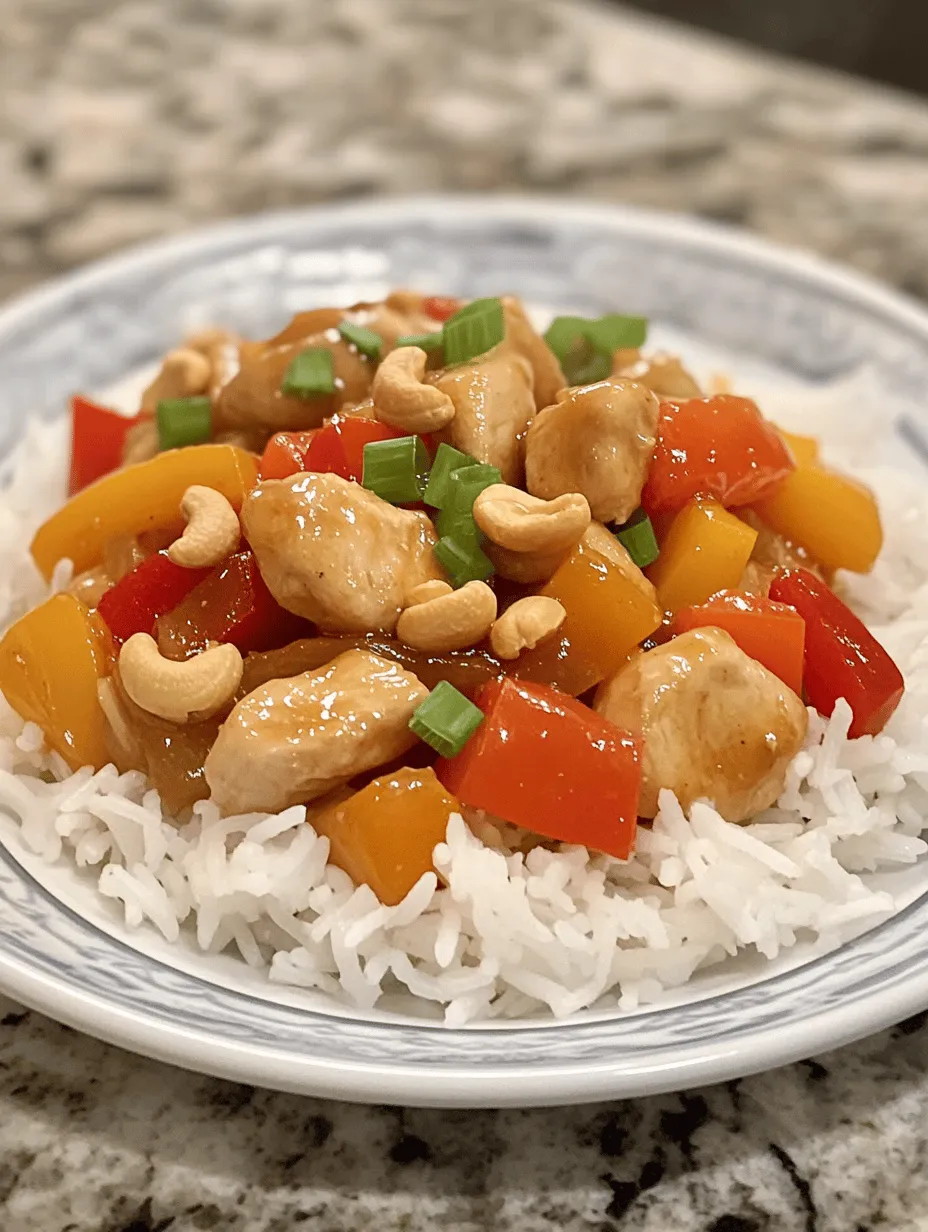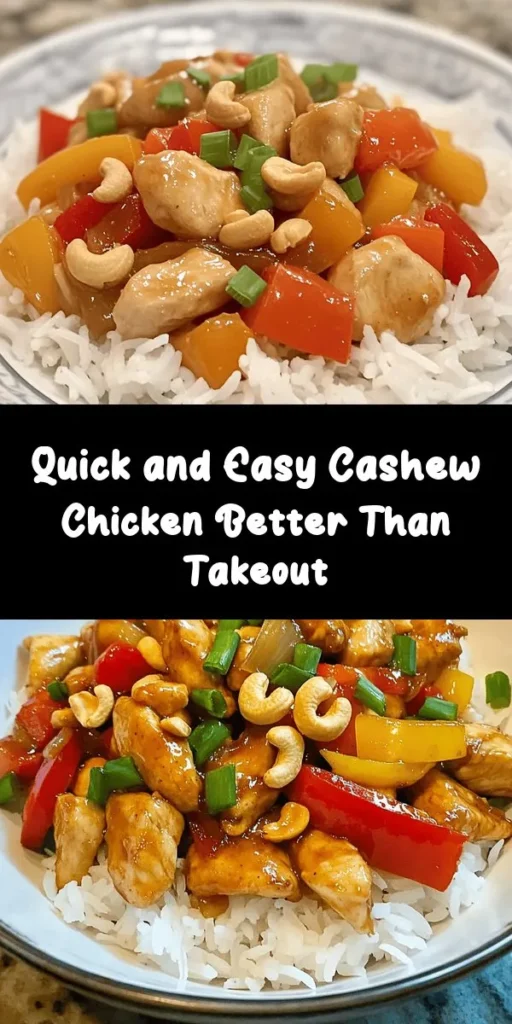Introduction
Cashew chicken is a beloved dish that has captured the hearts and taste buds of many food enthusiasts around the world. Known for its tantalizing combination of tender chicken, crunchy cashews, and vibrant vegetables, this dish is a staple in many Chinese restaurants. However, making cashew chicken at home can elevate your dining experience to new heights, offering flavors that often surpass takeout. With a few simple ingredients and straightforward steps, you can create a dish that’s not only delicious but also packed with nutrition.
Homemade meals have gained popularity in recent years, especially as more people seek healthier alternatives to takeout. While takeout is convenient, it often lacks the freshness and quality of a meal prepared in your own kitchen. By making cashew chicken at home, you can control the ingredients, adjust the flavors to your liking, and ensure that each bite is packed with wholesome goodness. This recipe not only provides a delicious meal but also promotes healthier eating habits by allowing you to use fresh vegetables and lean proteins.
The simplicity of this cashew chicken recipe makes it ideal for busy weeknights or as a meal prep option. With minimal prep time and quick cooking, you can enjoy a satisfying and flavorful dish in less than 30 minutes. This article will guide you through the history of cashew chicken, break down the key ingredients, and provide detailed preparation steps to help you master this delightful dish.
Understanding Cashew Chicken
Origin of Cashew Chicken
Cashew chicken is believed to have originated in the United States, specifically in Springfield, Missouri, during the mid-20th century. The dish was created by Chinese immigrants who adapted traditional Chinese recipes to suit American tastes. This fusion resulted in a dish that featured battered and fried chicken pieces stir-fried with a variety of vegetables and cashews in a savory sauce. The blend of flavors and textures quickly gained popularity, leading to its status as a classic Chinese-American dish.
Over the years, cashew chicken has evolved into various regional adaptations. In some versions, the chicken is served in a rich, thick sauce, while others feature a lighter, more delicate flavor profile. Different cultures have also put their own spin on this dish, incorporating local ingredients and cooking techniques that reflect their culinary traditions. This versatility is part of what makes cashew chicken a favorite among many, as it can be tailored to suit diverse palates.
Variations of the Dish Across Different Cultures
While the American version of cashew chicken is widely recognized, many cultures have their own interpretations of this dish. In Chinese cuisine, for instance, you might find a version that uses more vegetables and a lighter sauce, emphasizing the freshness of the ingredients. In some Southeast Asian countries, cashew chicken may be combined with coconut milk or served with rice noodles, adding a creamy texture and enhancing the overall flavor profile.
Other variations may incorporate different proteins, such as shrimp or tofu, providing options for those with dietary preferences. The flexibility of cashew chicken allows home cooks to experiment with various ingredients, ensuring that everyone can enjoy this delicious meal according to their tastes.
Nutritional Benefits of Key Ingredients
One of the most appealing aspects of cashew chicken is its nutritional profile. The key ingredients provide a range of health benefits, making this dish a great choice for those looking to maintain a balanced diet.
– Chicken: As a lean protein source, chicken is essential for muscle growth and repair. Using boneless, skinless chicken breasts not only reduces fat content but also provides a satisfying base for the dish.
– Cashews: These nuts are not only delicious but also packed with nutrients. They are a good source of healthy fats, protein, and essential minerals like magnesium and zinc. The crunchiness of toasted cashews adds a delightful texture to the dish.
– Vegetables: The inclusion of bell peppers, onions, garlic, and ginger not only enhances the flavor of the cashew chicken but also increases its nutritional value. Bell peppers are rich in vitamins A and C, while garlic and ginger provide anti-inflammatory and immune-boosting properties.
– Sauces: The combination of soy sauce, oyster sauce, and rice vinegar adds depth to the flavor profile while providing some essential nutrients. Soy sauce contains protein and various vitamins, while oyster sauce can offer additional minerals. Rice vinegar adds a tangy note without adding excess calories.
Overall, cashew chicken can be a wholesome meal choice, especially when prepared with fresh ingredients and balanced portions.
Ingredients Breakdown
Now that we’ve explored the background and benefits of cashew chicken, let’s dive into the essential ingredients needed to create this delicious meal.
Overview of Essential Ingredients
To prepare a mouthwatering cashew chicken, you will need the following essential ingredients:
1. Boneless, Skinless Chicken Breasts: Typically, about 1 pound of chicken is sufficient for 4 servings. This lean protein forms the base of the dish.
2. Cashews: A cup of roasted, unsalted cashews will add the signature crunch and flavor.
3. Bell Pepper: One medium-sized bell pepper, preferably red or green, will provide color and sweetness.
4. Onion: A medium onion, either yellow or white, will add a savory depth to the dish.
5. Garlic and Ginger: Freshly minced garlic (about 2-3 cloves) and ginger (1 tablespoon) are essential for flavor enhancement.
6. Soy Sauce: This will serve as the primary seasoning, adding saltiness and umami.
7. Oyster Sauce: For added richness and depth of flavor.
8. Rice Vinegar: A splash of rice vinegar will balance the flavors with its acidity.
9. Cornstarch: This is needed for marinating the chicken and thickening the sauce.
10. Vegetable Oil: For cooking, use a high smoke-point oil like canola or peanut oil to achieve a nice sear.
Chicken: Importance of Using Boneless, Skinless Breasts
Using boneless, skinless chicken breasts is crucial for this recipe. Not only do they cook quickly, but they also absorb flavors well, making them ideal for stir-frying. Chicken breasts are a lean source of protein, making them a healthier choice compared to darker cuts of chicken, which can be higher in fat.
When selecting chicken, look for fresh, high-quality breasts with a pink hue and minimal visible fat. If you’re looking for a more unique twist, feel free to substitute chicken thighs, which can offer a richer flavor and slightly juicier texture.
Cashews: Nutritional Value and Flavor Contribution
Cashews are a pivotal ingredient in cashew chicken, contributing both flavor and texture. These creamy, slightly sweet nuts are rich in heart-healthy fats, protein, and essential minerals such as magnesium. Toasting the cashews before adding them to the dish will enhance their nutty flavor, making them even more delicious.
When selecting cashews, opt for raw or lightly salted varieties. If you prefer a nut-free version, you can replace cashews with sunflower seeds or omit them entirely, although this will alter the dish’s texture.
Vegetables: Highlighting the Bell Pepper, Onion, Garlic, and Ginger
The vegetables in cashew chicken not only add color but also a wealth of nutrients.
– Bell Pepper: Provides a sweet crunch and is an excellent source of vitamins A and C. Choose vibrant colors for visual appeal and added nutrients.
– Onion: Adds a savory base flavor that complements the other ingredients. Onions are rich in antioxidants and have anti-inflammatory properties.
– Garlic: A powerhouse of flavor, garlic is known for its immune-boosting and heart-health benefits. Fresh garlic will impart a pungent, aromatic quality to the dish.
– Ginger: This root adds warmth and spiciness while providing digestive benefits and anti-inflammatory properties.
Together, these vegetables create a colorful and nutrient-dense variety that enhances both the visual appeal and health benefits of your cashew chicken.
Sauces: Role of Soy Sauce, Oyster Sauce, and Rice Vinegar
The combination of sauces in this recipe is key to achieving that authentic cashew chicken flavor.
– Soy Sauce: The primary source of saltiness in the dish, soy sauce is essential for enhancing umami flavors. For a gluten-free option, use tamari or coconut aminos.
– Oyster Sauce: Adds a rich, savory depth that elevates the overall taste of the dish. If you’re vegetarian or vegan, consider using mushroom sauce as a substitute.
– Rice Vinegar: Provides a tangy contrast to the richness of the sauces and balances the dish. It is essential for brightening the overall flavor.
Discussion on Ingredient Substitutions
One of the advantages of making cashew chicken at home is the flexibility to modify ingredients based on personal preferences or dietary restrictions.
– For those looking for a gluten-free option, ensure that you use gluten-free soy sauce or tamari.
– If you have nut allergies, consider replacing cashews with sunflower seeds or omitting them altogether while ensuring the dish remains flavorful.
– For a vegetarian or vegan version, substitute chicken with tofu, tempeh, or seitan, and ensure all sauces are plant-based.
This adaptability allows you to create a dish that meets various dietary needs while still delivering on taste.
Preparation Steps in Detail
To achieve the best results when making cashew chicken, it’s crucial to follow a few key preparation steps. Below, we detail the initial steps involved in this recipe, focusing on marinating the chicken and toasting the cashews.
Marinating the Chicken
Marination is a vital step in ensuring your chicken is flavorful and tender. To marinate the chicken, follow these steps:
1. Cut the Chicken: Begin by cutting the boneless, skinless chicken breasts into bite-sized pieces. This will allow for even cooking and better absorption of flavors.
2. Prepare the Marinade: In a bowl, combine soy sauce, cornstarch, and a dash of sesame oil. The soy sauce will provide flavor, while the cornstarch will help to tenderize the meat and create a glossy finish once cooked.
3. Marinate: Add the chicken pieces to the marinade, ensuring they are well coated. Cover the bowl and let the chicken marinate for at least 15-30 minutes. For best results, marinate for several hours or overnight in the refrigerator. This step is essential for flavor penetration and tenderizing the chicken.
Importance of Marination for Flavor
The marination process is essential for infusing the chicken with flavor and ensuring it remains juicy during cooking. The cornstarch in the marinade also plays a crucial role in achieving a velvety texture in the final dish. By allowing the chicken to soak in the marinade, you’re setting the stage for a deliciously flavorful experience.
How to Achieve the Best Results
To achieve optimal results with marination, consider the following tips:
– Use fresh ingredients: Fresh soy sauce, ginger, and garlic will yield the best flavor.
– Avoid over-marinating: While marination is beneficial, leaving the chicken in the marinade for too long can lead to a mushy texture.
Toasting the Cashews
Toasting the cashews is a simple yet crucial step that enhances their flavor and adds richness to the dish. Follow these steps to toast your cashews perfectly:
1. Preheat the Oven or Skillet: You can toast cashews in a dry skillet over medium heat or in the oven at 350°F (175°C). Both methods work well, but the skillet may require more attention to prevent burning.
2. Spread the Cashews: If using the oven, spread the cashews in a single layer on a baking sheet. If using a skillet, add the cashews directly to the pan.
3. Toast: If using the skillet, stir the cashews frequently for about 5-7 minutes or until they are golden brown and fragrant. In the oven, toast for about 8-10 minutes, checking frequently to ensure they don’t burn.
4. Cool: Once toasted, remove the cashews from the heat and allow them to cool slightly before adding them to the dish.
Why Toasting is a Crucial Step
Toasting cashews enhances their natural oils and brings out their nutty flavor, resulting in a richer taste and satisfying crunch. This step is often overlooked, but it significantly impacts the overall flavor profile of the dish. Toasted cashews will provide a delightful contrast to the tender chicken and crisp vegetables, making each bite a memorable experience.
By following these preparation steps, you’ll be well on your way to creating a better-than-takeout cashew chicken that is delicious, healthy, and satisfying. Stay tuned as we continue to delve deeper into the cooking process and provide additional tips to ensure your success in the kitchen.

Cooking the Chicken
To create the perfect Better-Than-Takeout Cashew Chicken, the first step is to ensure your chicken is cooked perfectly. Start by cutting boneless, skinless chicken breasts into bite-sized pieces. Not only does this help with even cooking, but it also makes for a more enjoyable eating experience.
In a large skillet or wok, heat a tablespoon of vegetable oil over medium-high heat until it shimmers. Carefully add the chicken pieces in a single layer, being cautious not to overcrowd the pan. If your skillet is small, consider cooking the chicken in batches to ensure that each piece gets the right amount of heat. Cooking in batches also helps achieve that coveted golden color and crispy texture without steaming the chicken.
Tips for Achieving the Perfect Texture and Color
– Marinate the Chicken: A quick marination in soy sauce, cornstarch, and a dash of sesame oil not only adds flavor but also helps in achieving a tender texture.
– Don’t Rush the Cooking: Allow the chicken to sear undisturbed for a few minutes before flipping. This promotes a nice brown crust, enhancing both flavor and appearance.
– Use the Right Temperature: If your skillet isn’t hot enough, the chicken will steam instead of sear. You want it hot enough to instantly start browning the chicken.
Importance of Cooking in Batches if Needed
If you find your skillet is too crowded, remember that patience is key. Cooking in batches allows for maximum caramelization. Remove the chicken once it is golden brown and cooked through (internal temperature should reach 165°F), and place it on a plate. Repeat with any remaining chicken, adding more oil if necessary.
Sautéing the Vegetables
After the chicken is cooked, it’s time to sauté the vegetables. In the same skillet, add a touch more oil if needed and toss in a medley of colorful vegetables—think bell peppers, snap peas, and broccoli. These not only add nutrition but also vibrant colors to your dish.
Techniques for Maintaining Vegetable Crunchiness
– High Heat: Cooking at high heat ensures the vegetables are quickly sautéed, which helps them retain their crunch.
– Timing: Add heartier vegetables like broccoli first, allowing them to cook for a minute or two before adding softer ones like bell peppers. This staggered approach ensures everything is perfectly cooked yet still crisp.
Flavor Combinations with Garlic and Ginger
Garlic and ginger are the perfect flavor enhancers for this dish. Add minced garlic and ginger to the pan with the vegetables, stirring constantly. The aroma will be intoxicating, and these ingredients help to build a flavorful foundation for your cashew chicken.
Combining Ingredients
Once your vegetables are vibrant and slightly tender, it’s time to combine everything. Return the chicken to the skillet, then add the cashews. The cashews will add a delightful crunch and richness to the dish.
The Significance of Letting Flavors Meld Together
After combining all the ingredients, pour in your prepared sauce of soy sauce, oyster sauce, and a hint of sugar. Stir everything together to ensure even coating. Let it simmer for just a few minutes; this is the time for the flavors to meld together beautifully.
Adjusting Seasoning and Final Touches
Before serving, taste the dish and adjust the seasoning as necessary. If you prefer a bit more saltiness, a touch of soy sauce can do the trick. For a touch of sweetness, a sprinkle of sugar or a drizzle of honey can enhance the overall flavor profile.
Serving Suggestions
When it comes to serving your Better-Than-Takeout Cashew Chicken, presentation matters. Serve it hot directly from the skillet or plate it onto a large serving dish.
Best Serving Practices for Presentation
– Layering: Create a base of rice or quinoa on the plate before adding the cashew chicken on top. This not only makes for a beautiful presentation but also allows the grains to soak up the delicious sauce.
– Color Contrast: Use a white or light-colored plate to highlight the vibrant colors of the chicken and vegetables.
Ideal Pairings: Rice vs. Quinoa
Both rice and quinoa are excellent choices to serve with your cashew chicken. If you prefer a classic takeout experience, go for steamed white or brown rice. For a healthier twist, consider serving it over quinoa, which is packed with protein and adds a nutty flavor that complements the dish perfectly.
Garnishing Options to Enhance Visual Appeal
To elevate your dish further, garnish with sliced green onions and a sprinkle of sesame seeds. Not only does this add a pop of color, but it also enhances the flavor profile with additional crunch and freshness.
Nutritional Information
This Better-Than-Takeout Cashew Chicken is not just delicious but also nutritious. Here’s a breakdown of the estimated nutritional information per serving:
– Calories: Approximately 400
– Protein: 30g
– Carbohydrates: 25g
– Fat: 20g
Highlighting the Health Benefits of the Dish
This dish is packed with lean protein from the chicken, healthy fats from the cashews, and plenty of vitamins and minerals from the vegetables. The addition of fresh ingredients ensures that you’re not only indulging in a tasty meal but also nourishing your body.
Discussing Portion Control and Serving Sizes
While this recipe is healthy, portion control is essential. Aim for a serving size of about 1.5 cups of cashew chicken over your choice of grains. This allows you to enjoy the flavors without overindulging.
The Benefits of Homemade Meals
One of the major advantages of making Better-Than-Takeout Cashew Chicken at home is the cost-effectiveness compared to ordering out. Not only does it save you money, but it also allows you to control the quality of ingredients used.
Control Over Ingredients and Health Benefits
When you cook at home, you can select fresh, high-quality ingredients, ensuring that your meal is both healthy and delicious. You can easily modify the recipe to fit dietary restrictions, preferences, or ingredient availability.
Family Bonding Through Cooking Together
Cooking together as a family can be a fun and rewarding experience. It fosters teamwork, teaches valuable cooking skills, and creates lasting memories as everyone gathers around the kitchen to prepare a meal together.
Conclusion
This Better-Than-Takeout Cashew Chicken recipe exemplifies the simplicity and deliciousness of homemade meals. With its colorful vegetables, tender chicken, and crunchy cashews, it’s a dish that appeals to everyone at the table.
Trying your hand at this recipe is a fantastic way to enjoy a healthier alternative to takeout, without sacrificing flavor. Embrace the joy of cooking and share the satisfaction of a home-cooked meal with your loved ones. Your kitchen will fill with delightful scents, and your dining table will be adorned with a beautiful, hearty meal that you can be proud of. So gather your ingredients, put on your apron, and dive into the wonderful world of homemade cashew chicken!



